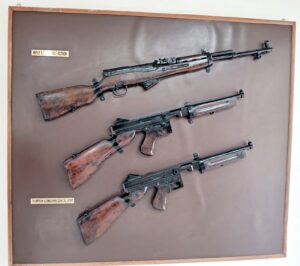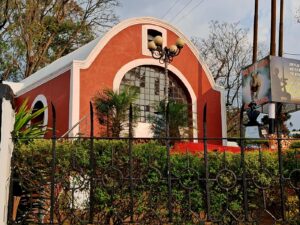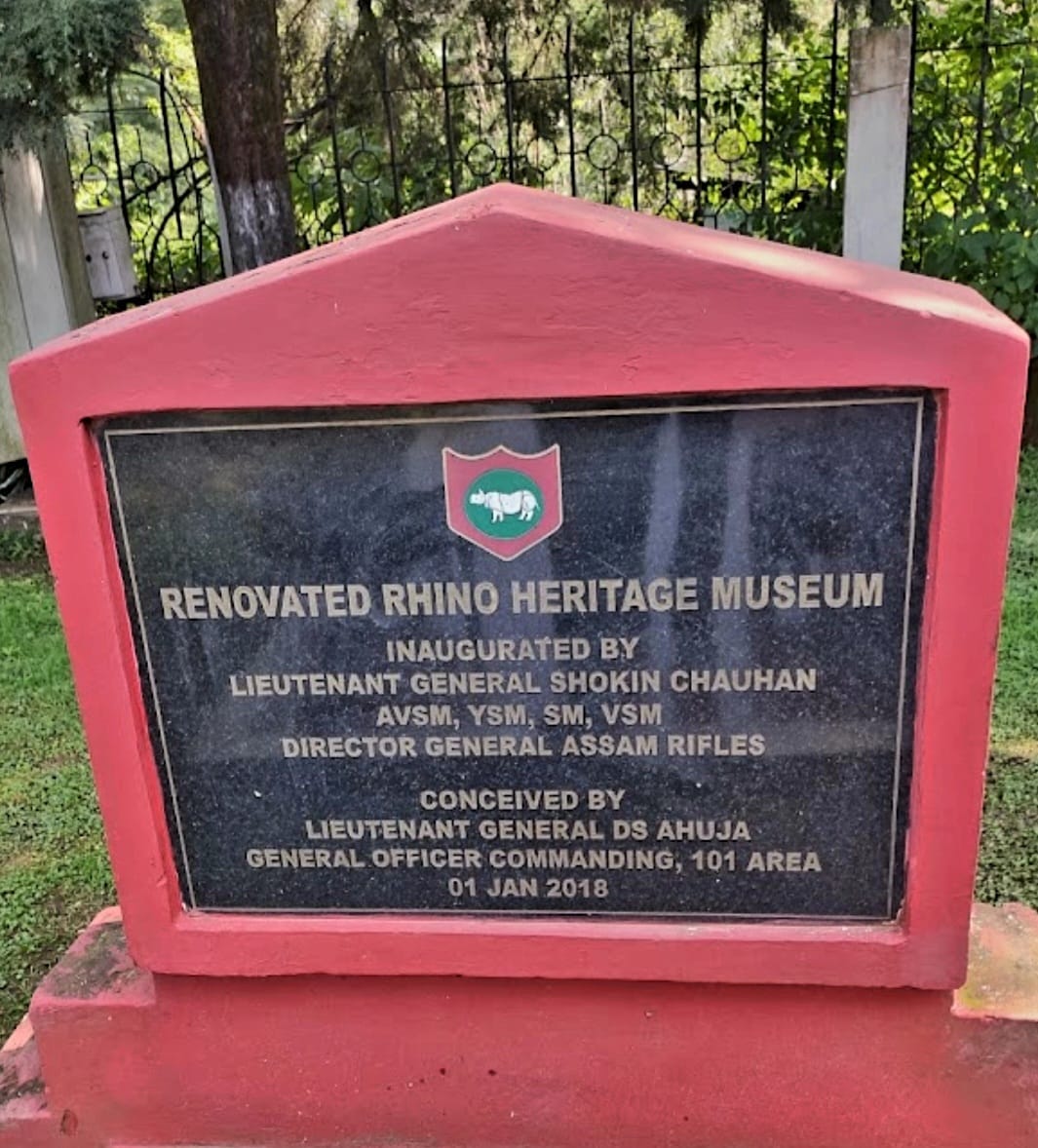Pratyusha Mukherjee, Shillong, Meghalaya
The Rhino Heritage Museum in Shillong showcases the Indian Army’s contributions, particularly those of the Assam Regiment and 101 Area, through displays of military history, artifacts, and historical photographs, serving as a tribute to their valor and sacrifices.
In this story we are featuring the Rhino Heritage Museum — a war museum which is dedicated to war heroes, military weapons and defence achievements.
Travelling through the busy Shillong-Guwahati highway, it is indeed hard to miss this pink coloured, semi-oval structure with round windows and with a magnificent sculpture of a rhinoceros placed at the foreground, symbolising resilience, courage, valour and determination.
As visitors enter the main gate, manicured gardens and well laid flower beds are a feast for the eyes and will surely make one want to stop for some beautiful pictures.
Things To See At Rhino Heritage Museum:
Being a war museum, the Rhino Heritage Museum is home to all kinds of artefacts from World War II. The visitors will get a detailed look into the war’s history.
Models Of Vehicles And Weapons Used In Wars:
The models show visitors the technology and innovations that were used to fight wars throughout history. Models of weapons from the World Wars, Indo-China Wars, and Kargil War are on display in the museum. These weapons look so realistic but they’re not real, or working and are specifically made for presentation.
Pictures of World Wars:
Rhino museum is also home to thousands of pictures from different wars such as the World Wars, the Kargil War, the Indo-China War, etc. Here you can see images of various events from wars, such as the photographs of the Peace treaty being signed by the Allies and Axis forces; images of soldiers in the midst of battle, during their small breaks between war.The museum depicts the history of the military in Shillong and its heritage structures, the 1971 Bangladesh Liberation War, war trophies and weapons and a section dedicated to gallantry award winners.
Belongings of Soldiers from World War II:
There are exclusive place in the museum dedicated to World War II , where we can see the remains of uniforms and medals of the martyrs. Apart from medals , uniforms and ribbons the place is also famous for displaying weaponry of the Japanese soldiers during the Second World War.

Brief History of the museum:
The Rhino Museum showcases the valiant history of 101 Area, the first army formation to reach Dhaka during the 1971 Indo-Pak War. The building in which the museum is housed was built in 1928 and is historically significant. During World War II, it served as a place of detention to Japanese soldiers. Historical photographs related to the military and the local culture have been displayed at this museum. A special gallery is dedicated to the memory of Capt. Keishing Clifford Nongrum, a brave Indian Army officer and martyr, who sacrificed his life during Operation Vijay (Kargil War) in July 1, 1999. Some of his photographs, letters written by his father, and some documents hand-written by him have been preserved and showcased. The museum also houses weapons used during the War of Liberation of Bangladesh.

Former Lieutenant General Shokin Chauhan, Director General of Assam Rifles inaugurated the renovated Rhino Heritage Museum on January 01, 2018.. Renovation of the Rhino Heritage Museum was a cherished desire of one and all.The museum has a dedicated corner for displaying the rich heritage, valour and courage of Assam Rifles- The Sentinels of North East. This heritage museum in Shillong is open to public.
A life – sized statue of Late Field Marshal SHFJ Manekshaw, Padma Vibhushan, Padma Bhushan, Military Cross was unveiled during the inauguration and a bust of Major David Manlun, Kirti Chakra(Posthumous) was unveiled by his parents.

Parents of Captain Clifford Nongrum, Maha Vir Chakra(Posthumous) paid homage to the officer on that auspicious occasion.
Since 1928, this unique-shaped structure has been used for various purposes. From a small arms store to a prison, the building was also used by the 1/8th Gurkha Rifles as a magazine to house their ammunition after World War II.
After Independence, this building was left unused until 1998-99 when it was given a new lease of life in the form of a museum. It is now a prominent landmark showcasing the valiant history of the 101 Area.
The Structure of Museum:
The interior and exterior walls of this heritage building are so thick that if ever, the structure is demolished; breaking through the walls would be a gigantic task.
The thickness of the exterior walls is roughly about 2 ft while the width of the interior walls measures approximately 1 ft.
Though small in size, this museum has a large collection of artefacts of historical importance. From old photographs of picturesque Shillong city and various military operations to weapons and write-ups on the walls, this three-room structure also displays old handwritten letters written by officers of the 1st King’s Gurkha Officers (KGO) and 2/7th KGO Gurkha Rifles to the IGP in Shillong dated 9th August and 23rd August 1921, narrating the regiments’ achievements during the First World War in France, Mesopotamia and Palestine.
Unseen pictures of The Dalai Lama being escorted by the military as he entered India from Tibet through Arunachal Pradesh in 1959 are also on display in the museum.
There is also a section in the main hall of the museum dedicated to Meghalaya’s very own Captain KC Nongrum, who sacrificed his life fighting Pakistani troops during the Kargil war in 1999 and Major David Manlun, a young Indian Army Officer from Manipur who was martyred while leading his team to hunt down militants in Nagaland in 2017.
The museum also accommodates a battle tank used during the Indo-Pak War in 1971. The ‘Vijayanta’ tank was moved from New Delhi to Shillong, covering a distance of 3,600 km in 2017. It was first pressed into service in 1966 and phased out in 2004.
A replica of the siren fitted on a pilot vehicle of Lieutenant General AAK Niazi, Martial Law Administrator and Commander of the Pakistan Eastern Command also finds place here. It may be mentioned that Lt Gen AAK Niazi signed the Instrument of Surrender at Ramna Race Course ground in Dhaka, Bangladesh in 1971. The other relic included an old telephone used by the Indian Army during the 1971 war.
It also has a room chock-a-block with information on the heritage, courage and compassion of the Assam Rifles, India’s oldest paramilitary force, headquartered in Shillong.
The Rhino Heritage Museum serves as a reminder of the supreme sacrifices of our soldiers to the nation and more importantly, it instils a sense of inspiration and encouragement to the future generation.
(Concluding part will be published tomorrow)
(Ms. Pratyusha Mukherjee, an Independent Sr. Broadcast Journalist working for British media with 20 years of experience in covering the east and northeast, with specialisation in Defence and Sports.She is associated with us as Editorial head of Defence and Sports. In her illustrated career she has covered many major events and achieved International and Indian media awards for Journalism)

